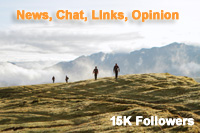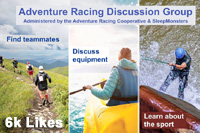Raid Gallacecia Expedition Race
Team Seagate in Spain at Raid Gallaecia
Nathan Fa’avae / 21.05.2015


I was out voted. I wanted to race Tierra Viva in Chile in April but Sophie and Stu wanted to race the Raid Gallaecia in Spain. My logic was Chile was only one long haul flight, Spain was two and either way we ended up in a Spanish speaking country, which to be honest, after racing in Brazil, Costa Rica and Ecuador in the past 18-months, I was open to the possibility of racing somewhere that didn’t require and mixture of sign language and poor attempts at local language to get simple tasks done. But who can complain when you lose a vote and end up traveling to Spain, tough life.
Chris had indicated that he wasn’t available to race due to gargantuan work commitments but would join us next at the Royal Belum Adventure Race in Malaysia in October, then onto the World Champs in Brazil in November. With my dwindling enthusiasm to race where the communication would be a struggle for us, we discussed inviting Spanish racer Albert Roca to join us for the race. Albert and Stu had raced a number of times together before and we agreed it’d be nice to have a local on board, removing one of the stresses we face with our limited linguistic vocabulary.
Our build up to the race wasn’t ideal, we’d all struggled to recover from Godzone juggling injury and illness and for me personally, a lack of motivation to get fired up. Stu went via China and raced the Baise stage race, he hadn’t had a good race there but was hoping to be on better form in Spain. Sophie was recovering from an injury that gave her some doubts as to how she’d go in the race, feeling the least prepared she’d ever been for a race. But we had only ourselves to blame, we were there and needed to get focused and race as best we could.
If you started drilling a hole from Hokitika and went through the centre of the earth you’d end up where we were, given Spain is the antipode of New Zealand it made sense to travel earlier to make the most of so much travel, about 30-hours of being belted into an aeroplane seat, fed and watered like a factory farmed animal.
Our meeting point was Santiago de Compestella. Gallaecia is the region in the north west of Spain, positioned above Portugal. It is often referred to as the wet part of Spain, with the weather patterns more akin to the United Kingdom as opposed to the Mediterranean. It is subject to cold air streams that race across the North Atlantic from Canada and Greenland. We were surprised how cold it was when we arrived, it felt like Dunedin in the winter, quite a shock when you travel to Spain at the start of summer expecting to go for a swim.
Santiago de Compestella is a city that has intrigued me for awhile so I was very happy to finally be there. The city has its origin in the shrine of Saint James the Great, now the city's cathedral, as destination of the Way of St. James, a leading Catholic pilgrimage route originated in the 9th century. In 1985 the city's Old Town was designated a UNESCO World Heritage Site. Each year about 1-million people travel the various pilgrimage routes that all congregate at the cathedral, which is an impressive place. Sophie and I arrived first and spent a few days training in the area, exploring the city, learning where we could and couldn’t go in our Iveco rental van. Testing the limits of height restrictions in parking areas and a few other road rules.
Stu and Albert arrived and we headed to the Viveiro area for some training, mountain biking, sea kayaking and coastal trail running. The coastline was spectacular but once away from the coast we generally found the landscape uninspiring. The region is very populated so it was difficult to get into wilderness areas, the region was also home to thousands of wind generation turbines so it seemed everywhere we went led to a towering windmill, plus the vegetation was vastly what we call in New Zealand ‘scrubland’, prickly wild berries, gorse, broom, pig fern, eucalyptus and pine plantations. However, the history and cultural aspects, the ruins and old buildings, stone walls, mills, an insight into life in Gallaecia, made up for it.
After a week of touring we arrived in the Thermal Resort town of Cuntis, the start of the race.
23-teams from Argentina, Belgium, Czech Republic, Finland, France, Sweden, Spain, UK and us from New Zealand. We expected Swedish team Haglöfs Silva and Spainish team Adventure Addicts to be the most likely to be battling for the podium placings.
The pre race days were relaxing and the packing of the gear was straight forward, aided by the fact
that each athlete had their own gear bag (versus more common method of having various TA boxes), having your own bag is a system I have not used since Eco Challenge, it’s certainly the best method from an athletes perspective.
I have to admit that when the course was announced I was concerned about the distance and time. The race was advertised at 400km with a winning time of 75-hours. This was pleasing to see as a 3-day race was all we wanted in light of having raced Godzone 8-weeks prior. It also suggested to me that a lot of teams should be able to finish the race, something that does not happen often enough and I believe has a detrimental effect on the sport.
However, when we got the race route it was over 500km and the winning time was predicted to be the same. I knew this was not going to be possible and it left me wondering why the course was increased by over 100km? As it turned out, I think the race would have been significantly better at 400km and more than 3-teams would have finished the full course. More course, more time, more distance does not equate to a better race in this sport, it has the reverse outcome. That said, this was the first expedition race the organisers had done and overall they did an excellent job. If the main improvement they need to make is to shorten the course, the event will only get better and more popular.
Stage 1 - Trekking 16km
Starting at a very civilised time of 9am we had a relaxing morning getting ready. The first stage was a loop from Cuntis running through forest trails and small towns in the surrounding hills. The nature of the navigation and all four team members having to punch the Sport Id box at each control meant that the field didn’t spread out much, starting the next stage about 7-8 teams were very close together.
Stage 2 - Mountain Biking 54km & Orienteering 7km
Stu was lead navigator for the team and it became apparent early on that getting into a rhythm on the biking stages would be difficult. The maps were very detailed and the 1:50000 was almost impossible to read while riding, so stopping frequently to read the map accurately became part of the event. This did mean it was hard to get separation from teams as they would catch up each time we stopped, it was actually quite funny, a large pack of riders cruising around. As the stage went on though the bunch got smaller until we were clear with Haglöfs Silva a few minutes ahead.
Midway through the ride we dropped our bikes and did an orienteering loop. I have to admit I found it a little disappointing, we were largely running firebreaks and logged areas, I couldn’t quite see the purpose of it, given the day was getting on and we had a big ocean kayak stage to follow, it made more logical sense to me to get onto the water with as much daylight as possible. The final part of the ride was really good and we transitioned to the kayak. We could see Haglöfs Silva up ahead.
Stage 3 - Kayak 45km
We kayaked out a river and onto tidal flats, not timing the tide well we slogged for an hour in shallow water before reaching the deep. Once in deep water we weaved through mussel farms towards an island, enjoying a visit by a pod of dolphins. Reaching the island for a short orienteering stage around some sandy trails. We were now just a matter of minutes behind Haglöfs Silva. There was no sign of any teams close behind us and that would remain that way for the rest of the race.
Back into kayaks we paddled about 5km to the other end of the island where we did another orienteering stage. We caught Haglöfs Silva during this stage and started the next kayak together.
We pulled away from them on the next 10km paddle, the wind increased pushing up a following sea to chase the occasional wave on. Once on land we did another orienteering stage around a small city. If you’re getting tired of reading about orienteering stages then you know how I felt in the race, I was getting tired of the kayak stage being constantly interrupted by random runs, it didn’t help I was feeling rubbish, I suspect a mild does of sun stroke from racing through the heat, pushing myself beyond what I’d trained for. Finally we could paddle to the end of stage, darkness set in and the temperature dropped. About an hour up river we arrived at the end of the stage. The impact of the cold was lessened when the TA staff fed us hot soup and coffee. The TA staff throughout the event really were splendid.
Stage 4 - Mountain Biking 68km
With Haglöfs Silva just behind us we set off into the night on bikes, soon climbing up the steep streets through a village, the mountain biking in the race was incredibly replicated. So many times we’d swear we’d passed the same place earlier in the race, ground hog style. The biking involved climbing steep streets through a maze between buildings, once out of the village even steeper climbs on trails would take us up and over a ridge, then it’d be a quick descent to a valley and the whole process would be repeated again. With so many roads route options were plentiful, essentially variations of the same route.
As the ride went on we’d see Haglöfs Silva then we’d split up again and regroup further up the trail. We swapped the lead many times but arrived at the end of the stage together. Each team having hits and misses in terms of choosing the fastest routes.
Stage 5 - Kayak 23km
After a quick transition we managed to get a gap and built up a lead in the paddle, which started in a lake then descended down river. There were some excellent rapids which we didn’t expect, some solid class 3, always a challenge when you’re paddling a sit on top, but lots of fun. The top section of the river was very technical and shallow but midway through the river tripled in size when another hydro scheme fed water back into the flow, it was all action then. The weather was warm but as our bodies fatigued, we’d start to get very cold as soon as we stopped moving. We exited the kayak with about a 30-minute lead.
Stage 6 - Canyoneering 4km
Next up was an un-timed stage through a canyon, dropping down to sea level. For the next hour we down climbed on huge grippy boulders, abseiled, jumped and swam across pools, often drowned out by the noise of cascading waterfalls. It was a superb stage and really exciting, one of the swims was particularly heart throbbing as we needed to swim the turbulent water at the base of a waterfall, I know enough about water hydraulics to know that we were skirting the edge of danger there. I typically find the ropes sections in races an inconvenience that almost always leaves you disappointed, but this canyon was brilliant. I guess that’s the trick with putting ropes in a race course, if you having something epic add it in otherwise don’t bother. It was a real shame that most teams did not get to do this stage as it’s these sections that can make an event unique and memorable. It was also a mammoth rigging job to set it up.
Stage 7 - Trekking 20km
The afternoon on day 2 we climbed through steep boulder country on the next hiking stage, with magnificent views over the ocean below. The landscape on this part of the trek was amazing.
Once over the top we descended into another valley that sadly was all scrub land, so for the next few hours we raced through countryside that had us asking ‘wtf?’. The later part of the stage was awesome again and to me summed up the whole race course in many ways. Had the stage been about 12km it would have been excellent, but the extra distance tainted the whole stage. It would have been one of the spots to shorten the course but increase the quality of the experience for the teams. The final part of the stage was enjoyable with the rich history, some of the ruins we passed by were fascinating.
Mandatory Rest Time 3-hours
Arriving at the TA we had to serve our compulsory rest. I’m not sure how the compulsory rest has crept into expedition racing but the faster it can creep out again the better, I don’t place any value on it in any shape or form, it’s a complete nuisance.
Firstly, TA’s are often the last place you want to rest as they are always so noisy, and this TA turned out to be noisier than a train station, it was almost impossible to get any rest. Added to that, teams always get energised at a TA, so by the time you have spent sometime getting ready for the next stage, you’re wired and ready to go. Sleeping the field when you need sleep is infinitely more beneficial. The other problem is that when there is a compulsory stop, you lose flexibility as to when to sleep as you’re compelled to push onto the forced stop, often pushing people on when really they need to rest, safety is compromised. It also removes tactics and responsibility from the teams.
So to summarise mandatory sleep, what it does is increase danger as teams take extra risks to get to the mandatory stops to rest, it takes away a teams freedom as to how they wish to race, it forces teams to rest at a place where the quality of rest will be of minimal benefit, it introduces an element of luck as some teams maybe ready to sleep and others are not. We found the rest stop in this race extremely frustrating and it made the next day or so very difficult because after being stopped for 3-hours already, we were reluctant to stop again even though we needed to. I hope other Race Director are reading this, whatever logic you may have about mandatory rest, I don’t think it works.
Stage 8 - Mountain Biking 30km
With lights shining we tackled the short but demanding ride through to stage 9. Same sort of ride, steep streets through a village, onto steeper trails etc… It seemed we had about an hour lead on Haglöfs Silva.
Stage 9 - Coasteering 52km
As we transitioned we could hear the weather deteriorating outside and 5-minutes into the stage we had to stop and wrap up in full wet weather gear as cold rain fell upon us. The stage started with us hiking out to Fisterra Lighthouse. This is somewhere I have long wanted to visit so it was unfortunate it was a black stormy night. In Roman times it was believed to be the end of the known world. Cape Finisterre is the final destination for many pilgrims on the Way of St. James.
This section of the race took us to the coast and we spent the day tracking up the coastline. The darkness hours were plagued with sleep deprivation making it really miserable. Thankfully once daylight arrived we got moving better. The scenery and coastline was dramatic and the views were vast and expansive. Golden sand beaches, huge sea cliffs, big pounding seas. We were not racing well through this stage and conceded a lot of time to Haglöfs Silva who we saw a few times as some of the controls were ‘out & back’ routes, not something that is very pleasurable when you’re doing an expedition race, you can start to feel like a rat on tread mill, walking around to fill in time.
The end of the stage was in Muxía, a coastal town and also one of the final destinations for pilgrims on the Way of St. James. After half a day of racing up the coast we were very pleased to get biking again.
Stage 10 - Mountain Biking 30km & Orienteering 6km & Trekking 14km
Holding the lead but only just we knew we needed to invest time in sleeping, we wanted to sleep in the field and find a place where we could rest in peace, in the sunshine. After passing a control we decided to sleep, I said to Stu we should find a place where other teams won’t see us, the reason being we don’t get woken up. He said if we go down this road we’ll be good as teams won’t be on this road. We collapsed on the grass and enjoyed the peace and quiet, warmth of the sun. Stopping for an hour I was woken up when Haglöfs Silva rode by, making quiet a bit of noise when they saw us, not intentionally but it did reduce the quality of our sleep. Then not long after a short course team came by and woke us up again. Back on bikes I was thinking “we’ll that’s just brilliant, we’ve now had two shit sleeps”. Luck was not our side in this race. Soon after we arrived in a town for another random (pointless?) orienteering stage, the most memorable thing was running past the stinkiest fish factory in the world. The TA staff though were awesome and the pasta they gave us was cuisine.
Darkness fell as we biked around the coast, this riding was my favourite in the race and not far into the ride we met up with Haglöfs Silva again who couldn’t find a checkpoint. We started to search too, we spread out looking and after about 20-minutes Albert found it, but amidst his excitement in finding the control he alerted Haglöfs Silva to where it was. We wasted an opportunity there to potentially get a gap, perhaps even a race winning move.
Back together we rode a short distance to the trekking stage, this was started with a coastal section on beaches and then climbed up into the hills, some challenging terrain to navigate through, it was beautiful night. Haglöfs Silva tucked in behind us for the stage letting us break trail and do the navigation. Once back on bikes we had about 10km of riding to the TA. Sophie had to fix her light before the ride and we lost contact with Haglöfs Silva who were quickly on their bikes. Then we floundered on the ride, sleep issues again. Once at the TA we snatched another 30-minute nap.
Stage 11 - Mountain Biking 60km
We’d enjoyed the close racing with Haglöfs Silva but it was during this stage that it ended. We made two errors that added up to nearly 2-hours and after that there was not enough race course left to recover from that. Starting the stage we were informed that CP93 had been cancelled but we were confused as to why. With me not being able to understand Spanish, the staff member did his best in English to tell me why and I came away thinking that it was because the CP was to hidden, it was deep in a pit. It seemed weird but I wondered if because we were having such a close race with Haglöfs Silva they didn’t want luck to enter the equation if a CP was to hidden. But Albert had been told by the race staff in Spanish and informed that the CP was not actually in place at all. When I told Stu all I really knew was that we no longer needed to go to CP93. What we didn’t know was that the route to CP93 was in fact slower than other routes, plus I wasn’t aware that Stu decided to take the route to CP93 anyway, so after a slog through some slow riding and we arrived at the CP I was really confused. Oh well, we’re here now.
Onto CP94. This is where we lost the bulk of the time and it was purely through navigation challenge. A combination of a tricky CP placement, sleep deprivation and pressure from Haglöfs Silva forced some errors that took us out of the race for first. Good racing on their part, credit to them.
Stage 12 - Trekking 35km & Orienteering 6km
The final stage was nearly 100% rideable and would have made an excellent biking stage. Walking on a biking stage can get a tad boring and it dragged on a bit, under a hot sun. As the day went on and kilometres ticked by we progressed towards the end. Once back into Santiago de Compestella we had one more orienteering stage to complete, this was was the epitome of pointlessness. We hiked up a hill to collect the orienteering map, then hiked directly back down the hill, then back to the top where we collected the map, then back down. The whole time questioning the relevance of it. Finally we were released from the claws of O-maps and allowed to find the finish line.
The race ended in the old city was a great place to close the journey, the Pilgrimage of AR. We finished a few hours behind Haglöfs Silva who scored a well deserved victory, I was thrilled to see them win a race after the bad luck they’ve had in the past two ARWC’s. Team Adventure Addicts of Spain were 3rd and the only other team to complete the full course.
I was pleased with our 2nd place, I felt we did the best with what we had. Whenever one of our core team members doesn’t race it always leaves a hole that can’t be filled, and Chris in particular leaves a big hole with his navigation prowess and physical strength. Stu did an excellent job navigating and raced strongly, Albert did well to race in a new team and adjust to different ways of doing things, Sophie didn’t have her signature style flawless race but she didn’t expect it either, other than struggling with the some sleep deprivation she was great. I struggled for the first few days, with motivation and at a pace I wasn’t conditioned to, but I raced into some form and the second half of the course I was better.
Summary
Overall the Race Management team did an excellent job given it was their first time delivering an expedition race. The staff were great and ultra helpful, very welcoming hosts which we highly appreciated. While there were a few things that could improve their event, they have to be credited for their effort and commitment.
The main issue to address is that their course was too long; 3 teams completing a race is simply not enough and does not help the growth of the sport. The Raid Gallaecia is not alone in this respect also. Godzone this year only had a small amount of teams completing the course too. I’m a firm believer that the sport needs more teams experiencing crossing the finish line of events.
I acknowledge that getting the timings right for an expedition race is a challenge in itself, but the first step is make sure that if it’s wrong, it’s better to come up shorter than end up longer. The reality is a lot of teams don’t have much expedition racing experience so they need to be nurtured through events, not tasked with near impossible courses that set them up for failure. When two of the top teams in the world are racing closely for 80+ hours, that’s equates to a monumental challenge for the bulk of the field, you could even say mission impossible.
It’s a shame a few stages were not dropped from the race as we went through it to ensure the winning time was under 75-hours, ideally about 70-hours. (I think 72-hours is the perfect length for a race, 3-days). The point being, if in doubt, make it shorter. I think AR World Series races should be 3-day winning times and the ARWC 4-days, that’s ample time to have a legitimate expedition race without making them so epic only a few teams finish.
Would I recommend the Raid Gallaecia as a race to do? Yes, absolutely, the event management team have the skills to deliver high quality events, having been impressed with their first expedition race, I believe they will learn, apply and create an even better event in 2016. The terrain on offer is really interesting and unique, the landscape and culture are both worthy, a race well worth doing.
Team Seagate wish the thank their sponsors:
Seagate, Rocky Mountain Bicycles, GU Energy, Absolute Wilderness Freeze Dry Meals, Torpedo 7, Antichafe, Patagonia Clothing, inov-8 footwear, Northface Packs, Nordenmark, Revelate Designs, Gloworm Lighting, Tineli, Wildside Travel, Bridgedale Socks, Wind Paddle, Xinix, Railriders, Ems Power Cookies








 SleepMonsters
SleepMonsters



